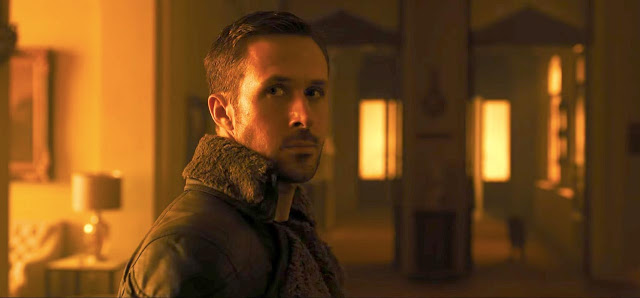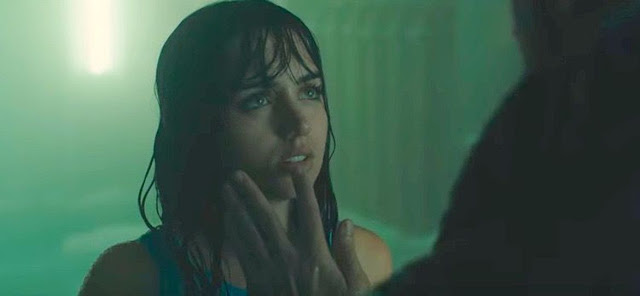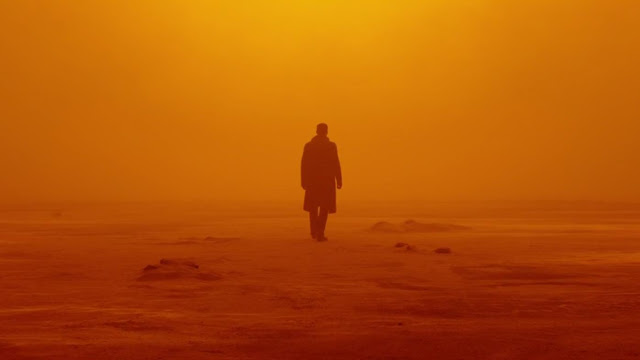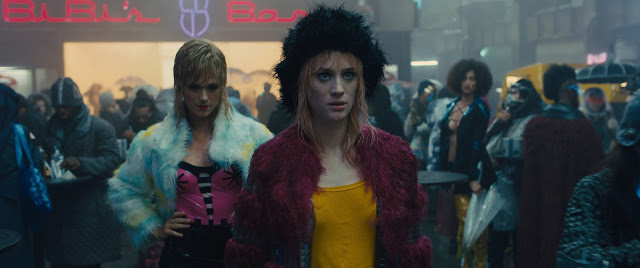Tears do indeed fall in rain in Blade Runner 2049, Denis Villeneuve’s grave and gorgeous sequel to Ridley Scott’s 35-year-old cult classic. Consider those tears an easter egg for the original’s ardent admirers. A vocal pocket of cinephilia can surely recite from memory the original Blade Runner’s “tears in rain” speech, delivered mournfully by Rutger Hauer on a desolate rooftop all those years ago. But while the passion of those fans doubtless drove the development of this follow-up, Villeneuve’s film does far more than simply pay homage to its predecessor. When I say that I’ve seen Blade Runner 2049, what I mean is—to quote the first line of Hauer’s soliloquy—I’ve seen things you people wouldn’t believe.
The exquisite craftsmanship of Blade Runner 2049 is staggering, but it is not exactly surprising. Over the past several years—beginning with Prisoners, then continuing with Sicario and Arrival—Villeneuve has demonstrated his ability to deliver robust, stealthily provocative genre films inside striking and elegant packages. And his regular cinematographer, Roger Deakins (aka “the legendary Roger Deakins”), is responsible for some of this century’s most breathtaking images, most notably in works by the Coen Brothers and Sam Mendes. Blade Runner 2049 represents these two artists operating at the absolute peak of their visual powers. This is, quite simply, a movie of flabbergasting beauty. Scene after scene reveals new marvels: a cloaked figure venturing into a burnt-orange desert, clouds of dust swirling around him; a sepulchral, yellow-tinted palace, where light and shadow swim on the walls; a giant glowing hologram, backlit by the night sky, beckoning to her minuscule quarry, a mere man who—like the rest of us—can only gape upward in awe.
So, yes, Blade Runner 2049 is admirable for its sheer technique alone—its dazzling displays of lighting, framing, and color. But as is usually the case, Villeneuve—working from a screenplay co-written by Hampton Fancher (who also wrote the original) and the prolific Michael Green (Logan, Alien: Covenant, American Gods)—has more on his mind than sensory pleasure. Taking its cue from Scott’s film, 2049 ruminates on the kinds of weighty metaphysical questions that tend to animate the best science-fiction: What does it mean to be human? Can machines ever truly be alive? Will our relentless pursuit of technology result in the forfeiture of our humanity? And why does Ryan Gosling always look so hot in leather jackets?
That last one requires little in the way of analysis, though it does evoke an interesting comparison. Gosling has bounced between genres and types throughout his career, but in recent years he’s established himself as a gifted comedian, combining his impossible handsomeness with a loose, rascally charm. (Last year, he delivered a career-best performance; he was also in La La Land.) Here, however, he submerges his innate charisma and instead channels the melancholic broodiness that he brought to Drive, when he carved his way through the LA underworld while carrying a scorpion-stamped coat and a death wish. His presence in Blade Runner 2049 is a curious piece of casting, one that doesn’t appear to play to his strengths; Gosling can of course hold a close-up, but forbidding him from smiling would seem to hamstring him, minimizing his natural allure. Yet his consciously reactive style makes a certain sense here because his character, called K, is a creature of passivity, an obedient agent of order.
Or is he? Mysteries of identity are central to the Blade Runner universe; that’s why fans have been furiously debating for decades whether Rick Deckard, Harrison Ford’s lethal bounty hunter from the original, was actually a replicant (author Philip K. Dick’s term for the androids that Deckard was paid to “retire”, i.e., gun down). One of the smartest things about 2049 is the way it retains its precursor’s preoccupation with the self but bends it into new shapes. For example, rather than toying with his audience about his hero’s nature, Villeneuve makes clear from the opening scene—in which K systematically pulverizes a rogue android (Dave Bautista)—that K is a replicant. This frankness would seem to shut down an area of speculative inquiry, but it actually opens new doors, one of which bursts ajar when a weary K heads home from work and settles down for dinner, which is served to him enthusiastically by Joi (Ana de Armas, very fine), his very own holographic helper.
It says something that the most complex and enriching relationship in Blade Runner 2049 is the one between two machines. Whether this is a product of writerly failure or directorial choice is unclear, and not especially important. What is clear is that the unclassifiable dynamic between K and Joi is fascinating, so much so that it threatens to dwarf the rest of the movie. Villeneuve, in a valiant stroke of herculean ambition, strives to marry K’s existential struggles to a sprawling noirish plot, one full of intrigue and double-crosses, shady villains and underground revolutions. After K learns that one of his replicant prey somehow birthed a child, he is ordered by his superior, Joshi (Robin Wright, just right), to kill the offspring; failing to do so, in her estimation, would surely result in war. K’s quest leads him to Luv (Sylvia Hoeks, making an impression), the android servant of Niander Wallace (Jared Leto, exhibiting his signature lack of restraint), a corporate visionary who designed the newest model of replicants and who appears to lack both a moral compass and a set of pupils.
All of this takes place against a backdrop that teems with detail, historical as well as visual. Certain elements—murmurs of a cataclysmic blackout; a sequence where K encounters an army of robot children manufacturing parts for a ruthless slaver (Lennie James, always welcome)—hint at a deep and rich mythology, the type that will send cyberpunk nerds scurrying to message boards and scribbling fan fiction. Yet the mystery plot of 2049 is not particularly taut or compelling. K’s gumshoe sleuthing yields the expected (or unexpected) twists and turns, but their payoff is muted. And while his inevitable reunion with Deckard—which Villeneuve teases with masterly patience—largely delivers, the film’s climactic rumble, though characteristically eye-catching, lacks resonance.
Or maybe the movie’s broader narrative just feels insignificant when compared with its luxurious textures and sharp swells of feeling. For what is nominally an action picture, 2049 is leisurely paced, taking the time to explore its characters’ emotions and to sink into their moods. This is most evident in K’s interactions with other non-humans. His tentative quasi-romance with Joi—a half-digital, half-corporeal assistant who seems to intuit K’s desires while also recognizing her own limitations—recalls the swooning love story of Her; an early scene on a rain-soaked rooftop where K reaches out to caress Joi’s glitchy, faltering face brims with sadness and longing. Tonally different, but similarly intriguing, is K’s verbal sparring with Luv, the two replicants intellectually circling one another like cautious boxers. And then there is Mariette (Mackenzie Davis, forever Cameron from Halt and Catch Fire), a replicant prostitute tasked by a shadowy figure to seduce K for reasons that could be benevolent, nefarious, or both.
What are Mariette’s motives? Who cares? During Blade Runner 2049’s best stretches, the obscure plotting melts away, allowing Villeneuve to focus on his principals with a startling combination of empathy and curiosity. That’s why the movie’s apex is not an action sequence, nor a plot twist, nor even a monologue about tears in rain. It is instead an astonishing scene in K’s apartment in which Joi and Mariette somehow merge bodies, their faces and limbs continually bleeding into one another, the light refracting off their skin as it shifts and seethes and settles. It is a quiet moment of three people attempting to discover more about one another. It is also one of the most extraordinary things I’ve ever seen on a movie screen.
In transcendent moments like that, Blade Runner 2049 realizes its full potential, using breathtaking cinematic technique to facilitate its dissection of humankind’s fears and needs. (The button to that scene—a brutally cutting remark from Mariette to Joi—highlights Villeneuve’s ability to spike his romanticism with acid.) The film is by no means perfect—it is simultaneously too busy and too sparse—but it repeatedly achieves perfection, and its bold philosophical sweep harmonizes with its artistic grandeur.
In one illuminating scene, K expresses hesitation to Joshi about killing the replicant child because he doesn’t want to murder anything with a soul. She waves him off, reminding him that he doesn’t have a soul, and he’s doing just fine. That’s a loaded retort, but the exchange emblematizes Blade Runner 2049’s essential spirit. That K lacks a soul is a matter of opinion. That this movie has one is a fact.
Jeremy Beck is the editor-in-chief of MovieManifesto. He watches more movies and television than he probably should.






The scene with Joi and K and Mariette was the best. Wonder if she's pregnant now?